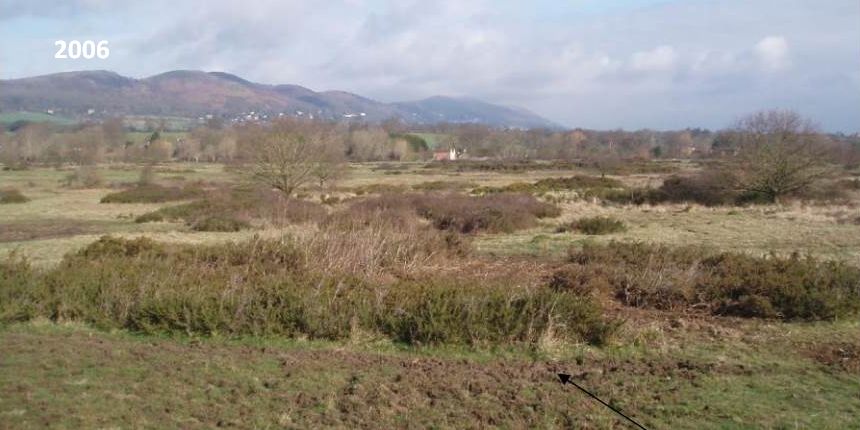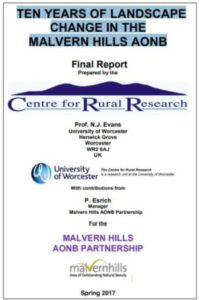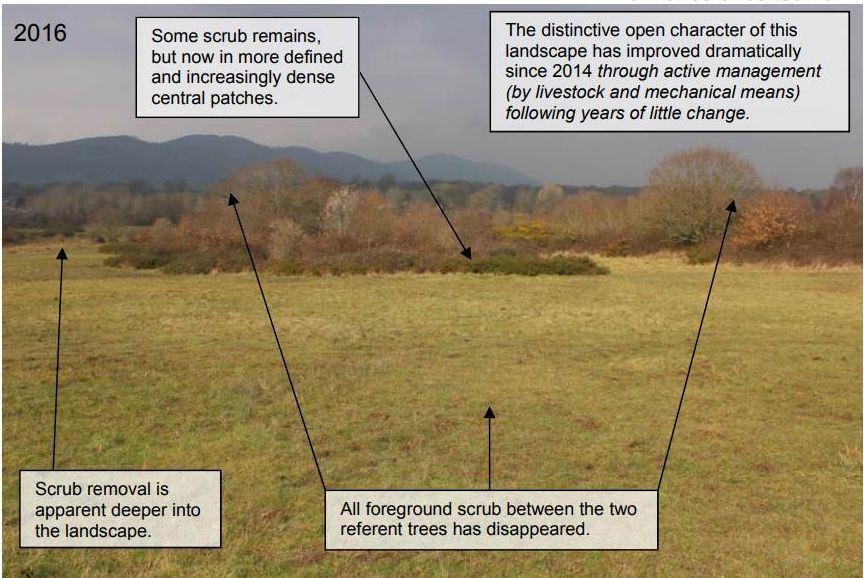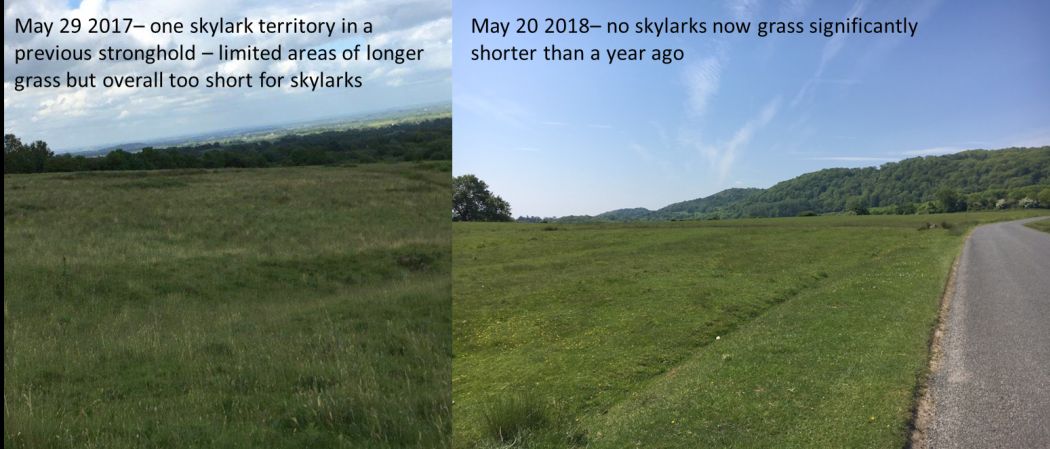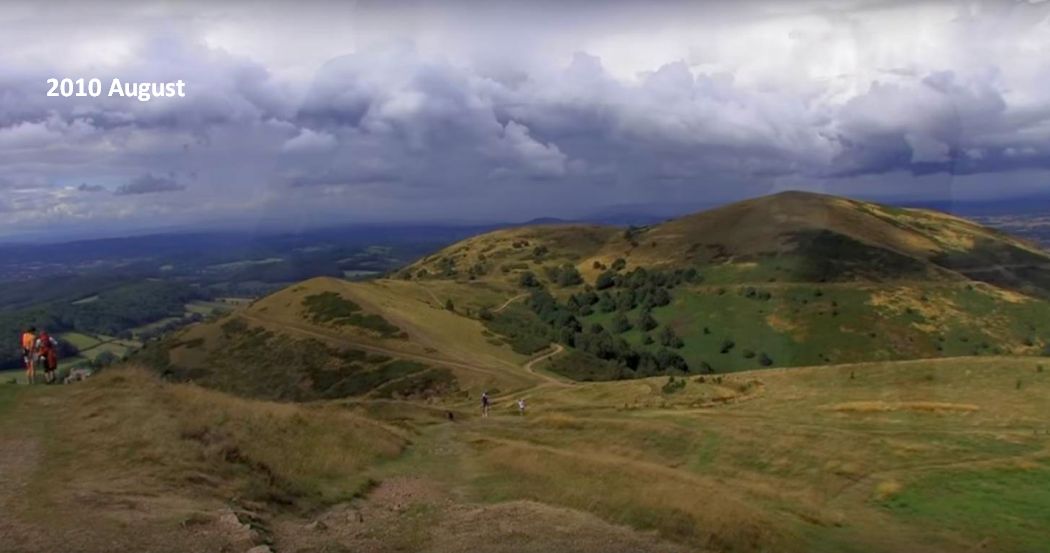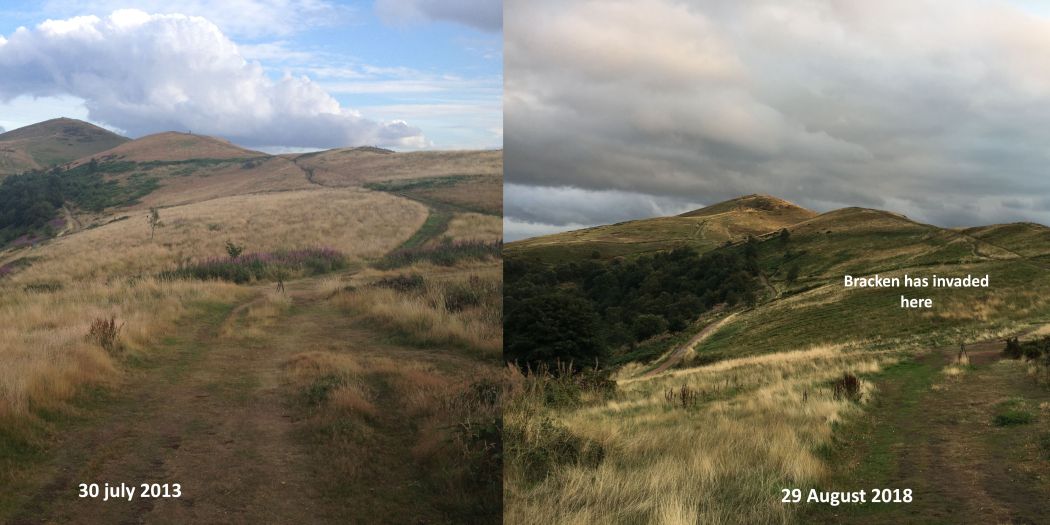Historically Malvern Hills and Commons were grazed extensively by those with rights. The last such grazing on the hills was in 1990 due to practical and economic concerns. In 2000 a grant enabled grazing to be reintroduced to the hills and this time the graziers were paid. The goal was to preserve open habitat by preventing scrub incursion. In the 18 years since then grazing has intensified as skylarks have declined to the point of breeding extinction on the high Malverns in 2015 and are now decreasing in numbers on the commons. MHT and Natural England maintain that grazing is needed to prevent scrub incursion. We believe the photo evidence below shows that grazing has done a good job in some areas but a bad job in others and that grazing policy needs to be much more nuanced and specific to different habitats:
Grazing on Castlemorton and Hollybed commons was and continues to be beneficial for scrub management, after scrub clearance to maintain open areas. However the grazing is now to tight in many areas and tighter than is needed to maintain open areas. Areas that held skyarks – and much else – when the grass was longer now do not. The trend is for shorter sward length puts the remaining 6 or so pairs nesting on Hollybed and Castelmorton Common under threat.
Poolbrook Common is meadow cut late in the year, maintaining the 20cm plus sward skylarks need and continues to hold 2 pairs of skylarks, despite considerable disturbance as a very popular dog walking spot. It is being well managed for skylark and other species as a meadow.
On the high hills the important SSSI feature is “Unimproved acidic grassland covers the top of the ridge which grades into tall herb communities at lower altitudes”. The photographs show what has happened to scrub in the last 18 years as grazing has intensified.
- Gorse invasion has tended to increase under grazing and the Trust has resorted to extensive mechanical control – not surprising as the cows and sheep avoid it.
- Bracken too too has been mainly controlled by mechanical means. There are some areas where bracken has actually increased under grazing and some where it has retreated a bit – though this probably follows mechanical control. This is not surprising as bracken control by stock alone is notoriously ineffective: wiping and mechanical control are more effective. It looks like bracken may be on the increase overall.
- The ridge tops were remarkably resistant to scrub incursion even with no grazing for 10 years from 1990 and very little in the years before that as commoner grazing declined. In 2000 a team* surveying skylark and meadow pipit numbers on the high hills noted “despite the fact that there has been little or no grazing in recent years on British Camp the grassy covering of chiefly Deschampsia Flexuosa has remained intact with insignificant encroachment. Why this should be needs further investigation but without the habitat the birds (skylarks) have no chance.” They noted more scrub incursion around North Hill. They recorded 16 skylark pairs on the high hills that year, 2000.
- Critically the pictures show that incursion creeps upwards from the lower slopes. It did not appear in the middle of the established acid grassland on the ridges in 10 years. This means you can control scrub incursion by controlling the margins without grazing the rest short. This would meet the SSSI specification of “unimproved acid grassland”, and provides habitat for skylarks and much else besides. It could possible provide a much needed defence against bracken incursion as un-grazed tightly matted wavy hair grass seems to provide excellent invasion protection.
- There is also evidence that stock are encouraging coarse weed invasion through trampling and dunging. This conflicts with maintaining the “unimproved acid grassland” of the SSSI.
* Peter Garner and Ian Duncan, highly respected local bird watchers and naturalists and editors of the excellent “Natural life of the Malverns” 2018. Neither is associated with the campaign – which of course did not exist in 2000. Early skylark records are thanks to Peter and others who surveyed in 1992, 2000 and 2004 and 2012.
Castlemorton Common 10 year comparison 2006 and 2016 (from TEN YEARS OF CHANGE – right)
Grazing helped maintain a more open landscape once it had cleared although it had to be cleared mechanically first. So far so good!
2017 and 2018 breeding sites comparison – but in the last few years the sward has become too short for skylarks in many places – there is no chance of skylarks nesting in the grass bottom right, next photo
On the Northern Hills looking from the Worcester Beacon to North Hill.
Below left is looking to the Beacon from the East side of North Hill in 2000 before grazing started again after 10 years plus absence. Taken to record the fire, it shows how dense matted Deschampsia Flexuosa seems to repel invaders. Any incursion occurs by creeping up the hill from the lower slopes.
2000
Below 2006 after 6 years of grazing
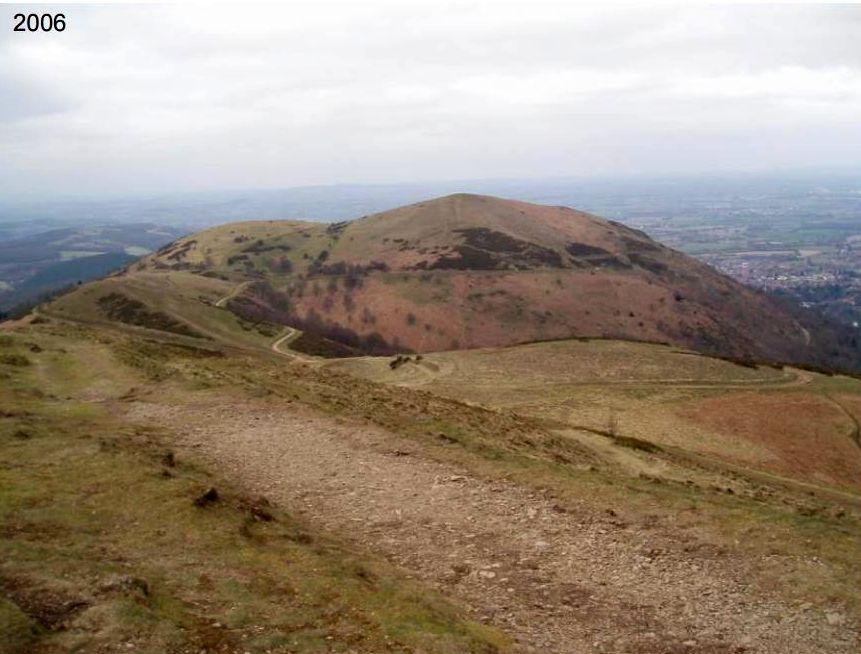
By 2010 there had been not much change with bracken – maybe a slight retreat bottom left? but gorse is increasing.
….but by summer 2018 below, the bracken needs to be controlled “invading bracken controlled by rolling”, there had been extensive mechanical clearing of the gorse on Table Hill in November 2017 (centre hill) and coarse weeds are on the increase in the foreground degrading the SSSI unimproved acid grassland feature.
Looking the other way from North Hill end to the Worcester Beacon shows where bracken has spread significantly in areas that have been open to grazing – the stock eat round it, hence the need for mechanical control.
While the scrub control battle is being mainly being fought on the margins between the mid-slopes and ridges the upper ridge slopes are being preferred by stock and grazed ever tighter. This habitat is no good for skylarks
The new 10 year grazing contract for the Northern Hills is expected to cost £541,000 over ten years for the Northern Hills alone. Grazing on the Hills south of the Wyche cutting all the way to British Camp and on Castlemorton covers a bigger area and so the costs are likely to be just as high in addition.
But not only is grazing is expensive, it is not working:
- The main scrub problem on the hills is bracken and the photo above shows how it has actually increased as grazing has intensified over the 5 years from 2013 to 2018 for example. It may well be that the best defence is tightly matted un-grazed Deschampsia Flexuosa. The photographs show areas where the trust has resorted to mechanical control (rolling) to stem the invasion because grazing doesn’t do it
- It is the same with gorse: animals will graze around it but not control it and so once again the trust needs to resort to mechanical cutting.
- Cattle especially bring coarse grass and weeds which establish in trampled areas and spread from there.
All of these limitations of grazing are well known in land management. So why spend so much on something that is not only bad overall for wildlife and does not provide the control it claims to.

